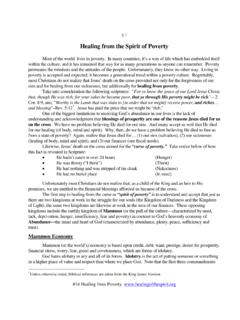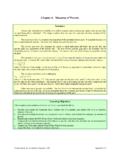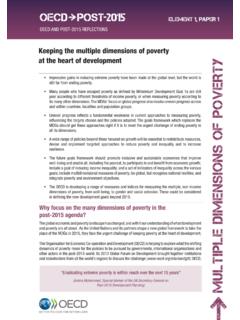Transcription of CHAPTER 2 THE DEFINITIONS OF POVERTY - World …
1 CHAPTER 2. THE DEFINITIONS OF POVERTY . Don't ask me what POVERTY is because you have met it outside my house. Look at the house and count the number of holes. Look at my utensils and the clothes that I am wearing. Look at everything and write what you see. What you see is POVERTY . A poor man, Kenya 1997. POVERTY is humiliation, the sense of being dependent on them, and of being forced to accept rudeness, insults, and indifference when we seek help. Latvia 1998. This CHAPTER explores poor people's DEFINITIONS of POVERTY as documented in the PPAs. We use an inductive approach to uncover dimensions of POVERTY that are important to poor people and to capture their characterizations of POVERTY .
2 This required us to set aside our prejudices and assumptions about what is important for poor people, about the importance of particular sectors in reducing POVERTY , about regional or gender differences, and about the best conceptual framework for understanding POVERTY . Hence, the organization of this CHAPTER and the concepts we use were determined by what emerged from our analysis of DEFINITIONS of POVERTY . There are five main findings. First, many factors converge to make POVERTY a complex, multidimensional phenomenon. Second, as expected, POVERTY is routinely defined as the lack of what is necessary for material well-being especially food but also housing, land, and other assets.
3 POVERTY is the lack of multiple resources leading to physical deprivation. Third, poor people's DEFINITIONS reveal important psychological aspects of POVERTY . Poor people are acutely aware of their lack of voice, power, and independence, which subject them to exploitation. Their POVERTY also leaves them vulnerable to rudeness, humiliation, and inhumane treatment by both private and public agents of the state from whom they seek help. Poor people also speak about the pain brought about by their unavoidable violation of social norms and their inability to maintain cultural identity through participating in traditions, festivals, and rituals.
4 Their inability to fully participate in community life leads to a breakdown of social relations. Fourth, the absence of basic infrastructure particularly roads, transport, water, and health facilities . emerged as critical. While literacy is viewed as important, schooling receives mixed reviews, occasionally highly valued but often notably irrelevant in the lives of poor people. Finally, poor people focus on assets rather than income and link their lack of physical, human, social, and environmental assets to their vulnerability and exposure to risk. This CHAPTER discusses the five findings and concludes with a case study on the large and newly impoverished population in Eastern Europe and Central Asia.
5 POVERTY is Multidimensional The evidence suggests that POVERTY is a multidimensional social DEFINITIONS of POVERTY and its causes vary by gender, age, culture, and other social and economic contexts. For 12. The numerous academic sources review the various quantitative methods for measuring POVERTY include: Sen 1997; Foster and Sen 1997; and Lipton and Ravallion 1995. For a less technical discussion of quantitative POVERTY measures, see Greeley 1994. For reviews of participatory and qualitative approaches to gathering information on POVERTY , see Chambers 1994; Salmen 1987, 1999; and Cernea 1985. 26. example, in both rural and urban Ghana, men associate POVERTY with a lack of material assets, whereas for women, POVERTY is defined as food insecurity.
6 Generational differences emerged as well. Younger men in Ghana consider the ability to generate an income as the most important asset, whereas older men cite as most important the status connected to a traditional agricultural lifestyle (Ghana 1995a). Perceived causes of POVERTY are affected by one's status and location. In Madagascar for example, farmers linked POVERTY to drought; the poor in the city to rising prices and fewer employment opportunities; the rich to deterioration in domestic and international terms of trade, neglect of Malagasay traditions and norms, lack of motivation among certain classes and groups of people, price liberalization and devaluation, lack of education and absence of governance (Madagascar, 1996).
7 POVERTY never results from the lack one thing but from many interlocking factors that cluster in poor people's experiences and DEFINITIONS of POVERTY . In Philippines, in the Mindanao region, women said we boil bananas for our children if food is not available. In some cases, when the Department of Agriculture distributes corn seeds, we cook these seeds instead of planting them. Ironically, they borrow money to acquire these seeds. The cycle of POVERTY continues as they are unable to pay for these loans (Philippines 1999). In Armenia, seasonal changes, lack of savings, and immediate cash needs interact to keep farmers poor: To cope, farmers barter or sell crops early in the summer or fall when the prices are low.
8 For example, 2 kilograms of honey (market price $20) were bartered for a sweater for a young child; and 10 kilograms of cheese (market price 10,000 drains) were bartered for a pair of shoes. One father explained: actually we have no income from August to September. As a result we need to barter goods and use them as money. Last year I. harvested my potatoes in mid-August and took them to Khapan to sell. I bought some necessary things for the children to go to school in September. So we suffered financially as the potatoes would have brought a better profit had we sold them later We usually barter potatoes and wheat for coats. But we don't have anything for bartering right now.
9 (Armenia 1996). In Guatemala, a Cackchiquel Indian who works as a hired agricultural laborer said, During the last eight years we have faced a greater state of POVERTY than before in that we can't buy much to eat and we suffer when it rains because there's no work and everything is very expensive.. Here in the community we don't have much hope to live better with what we earn. There are many needs, but the principle one is food, which is not sufficient, and we don't have a place to live or the means to pay rent (Guatemala 1994a). These interlocking dimensions of POVERTY come out clearly in the criteria poor people use to differentiate between categories of rich, average, and poor, as well in discussions of vulnerability.
10 (See Box 1 for indicators of wealth and POVERTY in Vietnam.). 27. Box 1. Summary of Household Wealth Indicators as Described by Poor People in Vietnam Relatively Well-Off Households Possess solid and stable houses that are usually renovated every 15 years Have transportation, either a motorbike or a bicycle or both Own a television Can send their children to school Never lack money even after the harvest has been eaten or sold Are able to save money Have a gardens with useful plants and trees Average Households Have a stable house that usually does not need renovating for ten years Own a TV and/or a radio Have enough food all year round Can send their children to school Have wells or easy access to water Poor Households Live in unstable houses, often made with mud Have no TV or radio Aren't able to save money Some have children who can't go to school.















